Blog
Subscribe
Join over 5,000 people who receive the Anecdotally newsletter—and receive our free ebook Character Trumps Credentials.
Categories
- Anecdotes
- Business storytelling
- Collaboration
- Communication
- Corporate Storytelling
- Culture
- Decision-making
- Employee Engagement
- Events
- Fun
- Insight
- Leadership Posts
- News
- Podcast
- Selling
- Strategy
Archives
- November 2024
- October 2024
- September 2024
- August 2024
- July 2024
- June 2024
- May 2024
- April 2024
- March 2024
- December 2023
Years
What kind of facilitator are you?
 At the upcoming Australian Facilitators conference I’m looking forward to the “Facilitator Archetypes” workshop that I’m running alongside a great cartoonist, Simon Kneebone. This workshop was inspired from some work we did earlier this year exploring language in facilitation. When I asked “what metaphor describes your style of facilitation” I had no idea it would result in such an interesting collection of characters. Characters like; The invisible facilitator. Facilitator as chameleon. Facilitator as dictator. Facilitator as conductor. Thanks to Simon, we have translated our initial findings into some great cartoons that capture these characters. I can’t wait to see what characters emerge from our workshop!
At the upcoming Australian Facilitators conference I’m looking forward to the “Facilitator Archetypes” workshop that I’m running alongside a great cartoonist, Simon Kneebone. This workshop was inspired from some work we did earlier this year exploring language in facilitation. When I asked “what metaphor describes your style of facilitation” I had no idea it would result in such an interesting collection of characters. Characters like; The invisible facilitator. Facilitator as chameleon. Facilitator as dictator. Facilitator as conductor. Thanks to Simon, we have translated our initial findings into some great cartoons that capture these characters. I can’t wait to see what characters emerge from our workshop!
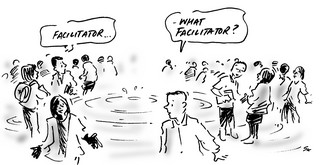
Figure 1. The invisible facilitator
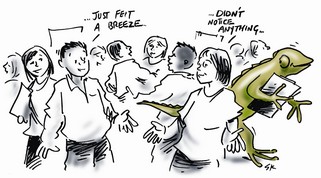
Figure 2: Facilitator as Chameleon
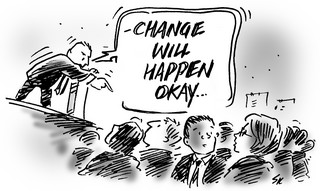
Figure 3: Facilitator as Dictator
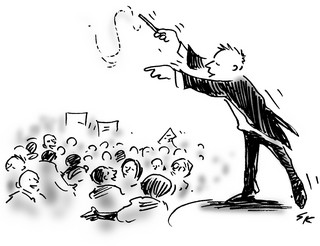
Figure 4: Facilitator as Conductor
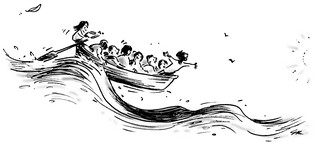
Figure 5: Facilitation is like moving with the elements and sailing the seas
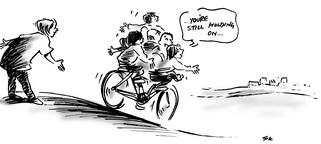
Figure 6: Facilitation is like a parent holding a bicycle and then letting go
What metaphor describes your style of facilitation?
About Andrew Rixon
Twitter •
Comments
Comments are closed.
Great piece, Andrew. On a good day, I’d like to be an invisible one, but if I’m honest, I’m rarely that. Somewhere between facilitator as fool and parent letting go.
Although at some conferences, I’ve veered close to dictator mode…
Dictator, conductor, chameleon … facilitator
Just as participation is about culture as much as tools, I believe facilitation is about style as much as technique. But like culture, that’s difficult to explain. Andrew Rixon of Anecdote has given us an excellent start in What kind
Thanks for sharing the great cartoons, I’ll tag them!
Are you talking about f2f, online or both? Is there a difference according to you? I worked with an experienced f2f facilitator, who worked for the first time online, and it’s amazing how easy it was for him.
Greetings, Joitske
Hi Joitske,
Thanks for your comments!
The characters came from a survey where we invited facilitators to describe what metaphor described their style of facilitation. The facilitators who took part, worked on the whole as f2f facilitators. We have a paper which we will be releasing shortly with more info on the survey, the results and the demographics etc.
Your question about whether there is a difference between online facilitation and face-to-face facilitation is a great one. In many ways it gets down to the question of ‘what are the essential skills of facilitation’?
I would say that the obvious big difference between f2f and online is the ‘body’ and ‘presence’ element involved in f2f. This to me is an enormous difference between the 2 environments. As we’ve found with our sociometry and action methods work, there is a huge difference between people raising their hand and asking a question, as opposed to bringing their body with the question within to a place of delivery.
What do you think?
Warm regards,
Andrew
What would a facilitator who “holds the space” look like?
What metaphor would capture a graphic facilitator?
Hi Nancy,
Great questions.
Many of the facilitators who participated in our survey were open space facilitators. I wonder whether the theme of ‘moving with the elements’ is somehow representative of ‘holding the space’?
In terms of graphic facilitators, I will be sure to ask some at the AFN conference in 9 sleeps time. 🙂
Warm regards,
Andrew